This is an old revision of this page, as edited by TheTransitFanNY (talk | contribs) at 21:36, 26 August 2024 (→Retired: cropped image). The present address (URL) is a permanent link to this revision, which may differ significantly from the current revision.
Revision as of 21:36, 26 August 2024 by TheTransitFanNY (talk | contribs) (→Retired: cropped image)(diff) ← Previous revision | Latest revision (diff) | Newer revision → (diff) Transit bus fleet operated and contracted by LACMTA
| This article needs additional citations for verification. Please help improve this article by adding citations to reliable sources. Unsourced material may be challenged and removed. Find sources: "Los Angeles Metro bus fleet" – news · newspapers · books · scholar · JSTOR (January 2015) (Learn how and when to remove this message) |

The Los Angeles County Metropolitan Transportation Authority (also known as "Metro", "MTA", or "LACMTA") operates a vast fleet of buses for its Metro Bus and Metro Busway services. As of September 2019, Metro has the third largest bus fleet in North America with 2,320 buses.
Overview
Metro and its predecessor agencies (LAMTA, 1951–64; RTD, 1964–93) have ordered buses from many manufacturers, including GM, Flxible, Grumman, AM General, Transportation Manufacturing Corporation (TMC), Neoplan USA, New Flyer Industries, ElDorado National, Orion Bus Industries, Thomas Built Buses, Blue Bird Corporation, and North American Bus Industries (NABI).
Emissions reduction
Metro has purchased buses using alternative fuels to diesel, generally consuming compressed natural gas (CNG), since the mid-1990s. The CNG fleet reduces emissions of particulates by 90%, carbon monoxide by 80%, and greenhouse gases by 20%. Alternative fuel buses have logged more than 450,000,000 mi (720,000,000 km) of operation since 1993, an industry record.
In 2015, a battery electric BYD K11M demonstrator was used on the G Line. Metro has committed to move the entire fleet to zero emissions by 2030, ahead of the California Air Resources Board's Innovative Clean Transit requirement for California transit operators to transition by 2040. Since then, the deadline has been pushed back to 2032. Metro board members subsequently rejected a move to delay fleet electrification until 2035. As a first step, the G (formerly Orange) Line will move to full zero-emissions operation by 2020, followed by the J (formerly Silver) Line as soon as possible after that. The G/Orange Line transitioned to all-electric operation by October 2021, using a fleet of 40 New Flyer Xcelsior XE60 Charge NG buses. Each bus has a range of approximately 150 mi (240 km), and rapid overhead charging stations were installed at the North Hollywood, Canoga, and Chatsworth stations.
As of the end of June 2024, due to heat stress and reliability issues with on route charging equipment, Metro has begun using 40-foot (12 m) CNG powered buses to supplement the G Line's dedicated battery-electric fleet. This undoes the G Line's electrification achievement, a long-standing Metro-touted victory in its troubled history of attempting to electrify its bus fleet. The de-electrification of the G Line is despite the board's recent direction to devise a new plan for electrification as soon as possible. Though many of Metro's previous failures have been attributed to its dealings with BYD, the problematic charging equipment on the G Line is manufactured by Siemens, and the buses on the G Line are manufactured by New Flyer.
Vehicle technology
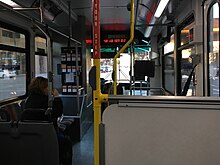
Metro has also increased its use of on-board vehicle technology. Many buses were equipped with monitors to display real-time bus maps to show the location through GPS navigation starting in 2004; this the first of its kind in the United States. Later, the screens began showing Transit TV broadcasts, including local news programs, starting in August 2006.
The screens were shut off and Transit TV service was discontinued in early 2015, as more passengers were relying on their personal mobile devices, such as cell phones, smartphones, and electronic tablets, for entertainment while riding the buses. The increased use of personal mobile devices by passengers led to the implementation of WiFi on all buses by April 2017. Also, as part of Metro's Advanced Transportation Management System (ATMS) project, most buses include a marquee displaying the date and time, Automatic Voice Annunciation (AVA) for audio and visual announcements of each stop, and an audio and visual "Stop Requested" announcement was added to all buses in 2008. A supplemental audio announcement of "For your safety, watch your step when exiting the bus" was added to all buses on February 28, 2013, and changed voice in March 2015.
Bus fleet
When it was formed in 1993, Metro inherited a large fleet of GM/TMC RTS diesel buses; these were initially replaced by Neoplan USA Transliner buses as they aged and retired. Starting in the early 2000s, the primary supplier to the Metro bus fleet was NABI, over a period of approximately 15 years. As one of its largest clients, Metro had considerable influence on NABI designs, including its bus rapid transit vehicles, the 60-BRT designed for the G Line and the composite-bodied Metro 45C, which was named after the agency and shared with Valley Metro.
After NABI’s closure in 2015, several variants of the New Flyer Xcelsior and the ENC Axess were purchased to replace the NABI fleet.
As of September 2019, Metro has the third largest bus fleet in North America with 2,320 buses, behind New York City's Metropolitan Transportation Authority (5,825) and New Jersey's NJ Transit (3,003). Metro operates the nation's largest fleet of compressed natural gas powered buses.
Metro electrified its G line BRT in 2021 using New Flyer XE60 vehicles along with on-route charging at the line's termini. This was undone in June 2024. It is in the process of receiving BYD K9M-ER vehicles which are undergoing delivery procedures and acceptance testing, slated to be used on the J line.
In April 2024, Metro released a procurement Request for Proposals for zero-emissions buses including hydrogen fuel cell vehicles and battery electric vehicles. The board also approved a motion directing Metro CEO Stephanie Wiggins and her staff to report to the board in September with an updated, more comprehensive and accountable plan to decarbonize the agency's bus fleet. These efforts were followed by the reversal of the G line's electrification, which had been a significant achievement in the agency's troubled history of attempting to electrify its bus fleet.
Active fleet
| Make/Model | Fleet Numbers | Picture | Year | Engine | Transmission | Divisions | Notes |
|---|---|---|---|---|---|---|---|
| NABI 60-BRT | 9500–9594 | 
|
2007–2008 | Cumnins Westport ISL-G | Allison B500R | 1, 5, 7, 13, 15 | |
| NABI 31-LFW | 3100–3149 | 
|
2009–2010 | Cummins Westport ISL-G | Allison B300R | MV, ST, |
|
| NABI Metro 45C CNG | 8100–8400 | 
|
2008–2010 | Cummins Westport ISL-G NZ
Cummins Westport L9N |
Allison B400R | 1, 3, 7, 8, 13, 15, 18, ST, MV |
|
| 8401–8491 | 
|
2010–2011 | Cummins Westport ISL-G
Cummins Westport L9N |
Allison B400R | 7, 8, 15, 18, ST, MV | ||
| 8500–8649 | 
|
2012–2013 | Cummins Westport L9N | Allison B400R | 1, 7, 13, 15, 18 | ||
| NABI Metro 40C CNG
(40CLFW-NOH) |
8650 |  |
2012 | Cummins Westport ISL-G | Allison B400R | CMF | Used for training |
| New Flyer XN40 | 5600–6149 | 
|
2013–2015 | Cummins Westport ISL-G
Cummins Westport L9N |
Allison B400R | 1, 2, 3, 5, 7, 8, 9, 13, 15, 18, MV, ST, |
|
| 3850–4199 | 
|
2015–2016 | Cummins Westport ISL-G
Cummins Westport ISL-G NZ Cummins Westport L9N |
Allison B400R | 1, 2, 3, 5, 7, 8, 9, 13, 15, MV | * Some units have begun their mid-life rehab
| |
| New Flyer XN60 | 8700–8764 | 
|
2018–2019 | Cummins Westport L9N | Allison B500R | 1, 13, 15, 18 | |
| 8765–8834 | 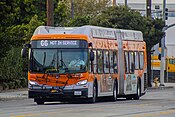
|
2020–2021 | Cummins Westport L9N | Allison B500R | 1, 7, 13, 15, 18 | ||
| ENC Axess BRT 40’ CNG | 1505–1799 | 
|
2018–2020 | Cummins Westport L9N | Voith D864.6 | 1, 3, 8, 9, 15, 18, MV |
|
| 1800–2061 | 
|
2020–2022 | Cummins Westport L9N | Voith D864.6 | 1, 3, 8, 9, 15, 18, MV | ||
| New Flyer XE60 | 19500–19539 | 
|
2019–2020 | Siemens ELFA2 | XALT Energy | 8 |
|
| BYD K11M | 19000–19004 | 
|
2020 | 8, CMF/13 |
| ||
| BYD K9MD | 10000–10004 | 
|
2021 | 9, 18 |
| ||
| 10005-10099 | 
|
2024 | 9, CMF |
|
Future
Retired
| Make/Model | Length | Picture | Year | Fleet Numbers (quantity ordered) |
Paint Schemes | Propulsion |
|---|---|---|---|---|---|---|
| Grumman Flxible 870 | 40 foot |  |
1980 | 7500-7729 (229 buses) |
RTD Tri-Shape
Yellow Jacket |
Diesel |
| GMC RTS-04 (T8J-204) | 40 foot |  |
1980-81 | 0023-0025 (3 buses) |
Purple Connector | Diesel |
 |
1980-81 | 8200-9139 (939 buses) |
ATE Ryder
RTD Tri-Stripe Yellow Jacket |
Diesel | ||
 |
1983 | 4452-4471 (20 buses) |
Blank | Diesel | ||
| Neoplan USA AN122/3 Skyliner | 40 foot |  |
1981 | 9902-9921 (19 buses) |
RTD Tri-Stripe | Diesel |
| GMC RTS-04 (T7J-604) | 35 foot |  |
1982 | 4400-4434 (34 buses) |
Yellow Jacket
Metro Local |
Diesel |
| Gillig Phantom | 35 foot |  |
1983 | 805213 (1 bus) |
Yellow Jacket | Diesel |
| Neoplan USA AN440A | 40 foot |  |
1983-84 | 3300-3714 (314 buses) |
Yellow Jacket | Diesel |
| Neoplan USA AN440A/3 | 40 foot | 
|
1987 | 1100-1189 (89 buses) |
Yellow Jacket | Diesel |
| Ford Econoline 350 | 25 foot |  |
1989 | 0006
(1 bus) |
Yellow Jacket | Diesel |
| TMC RTS-06 (T80-206) | 40 foot |  |
1988 | 2000-2266 (266 buses) |
Yellow Jacket
Metro Local |
Diesel |
 |
1989 | 1970-1999 (30 buses) |
Yellow Jacket
Metro Local |
Diesel | ||
 |
1989 | 2300-2402 (102 buses) |
Yellow Jacket | Diesel | ||

|
1992 | 1200-1502 (302 buses) |
Yellow Jacket Metro Local |
Diesel | ||
 |
1993 | 2006 (1 bus) |
None | Diesel | ||
| Flxible Metro B | 40 foot |  |
1988 | 2500-2649 (149 buses) |
Yellow Jacket | Diesel |
 |
1989 | 2700-2764 (64 buses) |
Yellow Jacket | Diesel | ||
 |
1990 | 2800-2870 (70 buses) |
Yellow Jacket | Diesel | ||
 |
1992 | 2900-2932 (32 buses) |
Yellow Jacket | Diesel | ||
| Gillig Phantom | 40 foot |  |
1988 | 19088, 19097, 19098, 19101, 19102, 19115, 19126, 19127 (8 buses) |
Yellow Jacket | Diesel |
 |
1989 | 9977 (1 bus) |
Metro Local | Diesel | ||
 |
1993-94 | 9978-9980 (3 buses) |
Metro Local | Diesel | ||
 |
1991 | 813-817 (4 buses) |
None | Diesel | ||
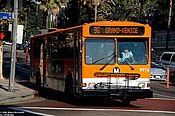
|
1994 | 9976 (1 bus) |
Metro Local | Diesel | ||
| Flxible Metro B CNG | 40 foot |  |
1989 | 1800-1809 (9 buses) |
Tri Stripe | CNG |
| Gillig Spirit | 28 foot |  |
1990 | 600 (1 bus) |
Yellow Jacket | Diesel |
| Gillig Phantom | 40 foot |  |
1994 | 1000-1010 (10 buses) |
None | Diesel |
| Neoplan USA AN440 | 40 foot |  |
1995-96 | 4500-4695 (195 buses) |
Metro Local | CNG |

|
1996-97 | 4696-4793 (97 buses) |
Metro Local | CNG | ||

|
1997-98 | 6301-6600 (299 buses) |
Metro Local | CNG | ||

|
1999 | 6700-6799 (100 buses) |
Metro Local | CNG | ||
| New Flyer D30LF | 30 foot |  |
1997-98 | 9981-9983 (3 buses) |
Metro Local | Diesel |
| New Flyer D40LF | 40 foot | 
|
1998 | 3000-3019 (19 buses) |
Metro Local | Diesel |
| New Flyer C40HF | 40 foot | 
|
1999-2000 | 5000-5222 (122 buses) |
Metro Local | CNG |
| NABI 40-LFW | 40 foot | 
|
1999-2000 | 7000-7214 (215 buses) |
Metro Local
Metro Rapid Metro Express |
CNG |

|
2000-01 | 7300-7514 (215 buses) |
Metro Local
Metro Rapid |
CNG | ||

|
2001-02 | 7600-7949 (350 buses) |
Metro Local
Metro Rapid |
CNG | ||

|
2005 | 7525-7599 (75 buses) |
Metro Local
Metro Rapid |
CNG | ||
| New Flyer C40LF | 40 foot | 
|
2000-01 | 5300-5522 (223 buses) |
Yellow Jacket
Metro Local Metro Rapid Metro Express |
CNG |
| Orion VI | 40 foot | 
|
2000-01 | 11001-11067 (67 buses) |
Metro Local | Diesel |
| Thomas TL960 | 40 foot |  |
2001 | 9950-9969 (19 buses) |
Metro Local | Diesel |
| Blue Bird CSRE 3703 | 37 foot | 
|
2001 | 9970-9975 (5 buses) |
Metro Local | Diesel |
| ElDorado National MST II | 32 foot | 
|
2002 | 12501-12536 (35 buses) |
Yellow Jacket | Diesel |
| ElDorado National E-Z Rider II | 30 foot | 
|
2003 | 12556-12570 (14 buses) |
Metro Local | Propane |
| NABI 40C-LFW | 40 foot | 
|
2002-03 | 7980-7999 (20 buses) |
Metro Local
Metro Rapid |
CNG |
| NABI 45C-LFW | 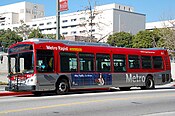
|
2003-2004 | 8000-8099 |
Metro Local
Metro Rapid Metro Liner |
CNG | |
| NABI 60-BRT | 60 foot | 
|
2004-06 | 9200-9399 (200 buses) |
Metro Local
Metro Rapid Metro Liner |
CNG |

|
2006-07 | 9400-9495 (96 buses) |
Metro Local
Metro Rapid Metro Liner |
CNG | ||
| NABI 42-BRT | 42 foot | 
|
2008-09 | 4200-4205 (5 buses) |
Metro Local | Gasoline-Electric |
| BYD K9 | 39 foot | 
|
2014 | 1001-1005 (5 buses) |
Metro Local | Electric |
Liveries
-
RTD Copperhead (Flxible New Look)
-
 RTD Tri-Stripe (Neoplan AN440)
RTD Tri-Stripe (Neoplan AN440)
-
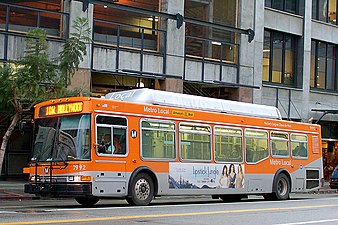 Metro Local (NABI 40C-LFW)
Metro Local (NABI 40C-LFW)
-
 Metro Rapid (NABI 45C-LFW)
Metro Rapid (NABI 45C-LFW)
-
 Metro Express (NABI 40-LFW)
Metro Express (NABI 40-LFW)
-
 Metro Liner (NABI 60-BRT)
Metro Liner (NABI 60-BRT)
Predecessors
In 1971, RTD took delivery of the first units of its Flxible New Look fleet, painted in a "Copperhead" livery which RTD described as "orange and champagne". The livery, as implemented on its GM and Flxible "New Look" fleet, had the window area painted in ochre yellow and the lower body and front painted in champagne/copper, separated by a broad silver or white stripe down the sides. When RTD introduced a 25 cent flat-fare program in 1974, some of the reserve buses pressed into service were painted a plain white instead of "Copperhead". In 1976, the existing GM Old Look bus fleet were repainted in the new "Copperhead" livery. RTD introduced an "Express" livery in 1977, colored yellow, white, and black, with a broad wedge-shaped stripe down the side.
RTD introduced the "Tri-Stripe" livery in March 1980, designed by Saul Bass and Herb Yager, starting with the existing Grumman/Flxible 870 fleet and continuing with the Rapid Transit Series scheduled for delivery in October 1980. Under this scheme, the window area was painted black and the base was painted white, separated by red, orange, and yellow stripes. The Bass/Yager firm was engaged to rebrand the agency, including a new logo, in June 1979 after the increase in ridership driven by the 1979 oil crisis proved that many residents were unfamiliar with RTD. The oldest "Old Look", which was also the first diesel bus to operate in Los Angeles starting from 1950, was retired with the delivery of the last RTS in June 1981. Most of the existing "New Look" fleet was repainted in the Bass/Yager "Tri-Stripe" livery by August 1984. "Tri-Stripe" was simplified in the early 1990s to facilitate graffiti removal.
Initial stripe schemes
Buses inherited from RTD generally carried over a simplified "RTD Tri-Stripe" livery; the base color of the bus was white (including the window area) with a triple-stacked stripe of red, orange, and yellow extending from the base of the windshield down the sides of the bus, carried below the side windows. This was simplified to "Red Stripe", white with a double-stacked stripe of red and yellow in the same position, and "Yellow Jacket" in 1997, white with a double-stacked gold stripe in the same position, featuring a stylized text logo "Metro Bus" prominently on the front and sides of the bus.
Service livery
Starting in the early 2000s, the "Metro Service" livery was implemented under the leadership of creative director Michael Lejeune and lead designer Neil Sadler. The base color of buses, visible on the lower edge and the extended roof cap for CNG storage, was Silver / Pantone 877 C metallic, supplemented by a broad stripe starting just below the side windows and extending to the top of the bus, denoting the service type:
- Metro Local: Local poppy / Pantone 158 C for local service
- Metro Rapid: Rapid red / Pantone 193 C for rapid (limited) service
- Metro Express: Express blue / Pantone 286 C for express (freeway) service
- Metro Liner: Liner silver / Pantone 8401 C for bus rapid transit lines
The colors are supplemented by text restating the service type in the FF Scala Sans typeface, bold weight. This branding scheme won an honor award from the Society for Experiential Graphic Design in 2007. Since then, the Express services have been scaled back and the colors have been modified.
Simplification
Typically, the supplemental text agree with the livery, such as Metro Local used with the Poppy Orange color. However as of late 2020, Metro dropped the text specification for newer buses and those undergoing their midlife refit. Since then, beginning with the second batch of New Flyer XN60s delivered in 2020-2021 and newer (buses 8765 and newer), buses are now simply labeled "Metro Bus" echoing the "Yellow Jacket" livery while buses still retain the "Service" color distinctions for local, rapid, and liner liveries. New Flyer XE60s used to replace the G Line fleet and convert it to zero-emissions operation were delivered before this change in late 2020, and as such, use a "Go Metro" label not found on other buses. Other buses feature a large text "Go Metro" on their roof rails, however not as a bus label such as "Metro Rapid", "Metro Local", or "Metro Bus". Since then, BYD K-series vehicles on the J line and newer buses have adopted the "Metro Bus" labels, defining that label as the preferred option moving forward.
The XE60s that replaced the NABI Metro Liners on the G (Orange) line dropped the orange accents and text colors so they could be used elsewhere without too much confusion. Although there are currently no other divisions or lines that are equipped with the required supporting infrastructure, Metro may need to conduct early replacement of the XE60s in favor of larger, potentially double-articulated vehicles for the G line, as the line is at capacity and needs an upgrade before its eventual conversion to light rail. Thus, the flexible branding enables Metro to reassign the XE60s currently belonging to the G line without needing to take them out of service for re-brands.
With the same logic, new J line buses are no longer branded with the tagline "A faster way to downtown" as old J line buses are entering service on other routes such as the 2 with the addition of BYD K9Ms to electrify the J line and the fact that new electric busway-designated buses are also sometimes used on innagural runs of new routes such as the 33 in addition to local service and thus don't feature exclusive branding to the busway line the bus is normally usually assigned to.
Metro Bus & Rail divisions
5miles 24 23 22 21 20 19
- Bus
- Non-revenue / closed
- Rail (A)
- Rail (B/D)
- Rail (C)
- Rail (E)
- Rail (K)
1 Downtown LA / Central City
2 Downtown LA / Crossroads Depot
3 Cypress Park
4 Non-revenue (Downey)
5 Arthur Winston
6 Venice
7 West Hollywood
8 Chatsworth / West Valley
9 El Monte
10 Los Angeles
11 Metro A Line (Long Beach)
12 Inactive vehicles (Long Beach)
13 Downtown LA
14 Metro E Line (Santa Monica)
15 Sun Valley
16 Metro C/K Line (Westchester)
17 Maple Terminal
18 South Bay
19 El Monte Station
20 Metro B/D Line (Los Angeles River)
21 Metro E Line (Elysian Park)
22 Metro C Line (Hawthorne)
23 La Veranda Apartments
24 Metro A Line (Monrovia)
Under the Metro governance structure, the routes operating out of each division are supervised by an integrated/centralized operations division with oversight provided by one of five Service Councils covering a distinct geographical region of Los Angeles County. Each Service Council has a three-letter abbreviation.
Each Service Council is composed of elected officials, appointed representatives, and transit users from a given area served by each division. While the Councils have geographical boundaries, in practice they only define where the members come from, as most of Los Angeles is served by routes operating out of multiple sectors. For instance, the former Olympic Boulevard Rapid bus was operated by buses from the San Gabriel Valley sector, despite its entire route being in the Westside or Central Los Angeles areas.

Decals with service sector abbreviations and division numbers are affixed to the windows of Metro buses. A list of routes operating from each sector can be found in the Service Council Bylaws.
Division 3 in Cypress Park is the oldest bus yard owned by Metro, operating since 1907. About 200 buses currently operate out of the yard.
The following table lists all current bus divisions (rail divisions are not included):
| Number | Name | Sector |
|---|---|---|
| 1 | Central City | Gateway Cities |
| 2 | Crossroads Depot | Gateway Cities |
| 3 | North Los Angeles, Cypress Park | San Gabriel Valley |
| 4 | (non-revenue vehicles) | Gateway Cities |
| 5 | Arthur Winston/Mid-Cities | South Bay |
| 7 | West Hollywood | Westside/Central |
| 8 | West Valley | San Fernando Valley |
| 9 | El Monte, San Gabriel Valley | San Gabriel Valley |
| 10 | East Los Angeles (all retiring vehicles, construction staging for other divisions) | Gateway Cities |
| 13 | Downtown Los Angeles | Central Maintenance Facility (CMF) |
| 15 | East Valley | San Fernando Valley |
| 18 | South Bay | South Bay |
Division 10 was closed for revenue service during the COVID-19 pandemic in September 2020. Vehicles were re-assigned, however Metro has kept the property. It will be used to store other buses when their respective divisions are being equipped for zero-emissions revenue service. Due to the nature of the upgrades required at each division, some divisions may need to temporarily relocate their current CNG buses to have enough space for construction.
Closed divisions
The following table lists all former divisions.
| Number | Name |
|---|---|
| 6 | Venice |
| 12 | Long Beach |
| 14 | South Los Angeles |
| 16 | Pomona |
See also
- Bus transportation in California
- Los Angeles County Metropolitan Transportation Authority topics
- Los Angeles Metro Rail rolling stock
References
- Metro Countywide Sustainability Annual Report (PDF) (Report). Los Angeles County Metropolitan Transit Authority. March 2019. Archived (PDF) from the original on August 16, 2021. Retrieved December 30, 2021.
- Honor, Joni; Sotero, Dave (October 13, 2021). "L.A. Metro Now Running all Zero-Emission Electric Buses on the G (Orange) Line in the San Fernando Valley" (Press release). Los Angeles County Metropolitan Transit Authority. Archived from the original on December 30, 2021. Retrieved December 30, 2021.
- "COO Report — July 18, 2024" (PDF).
- "G Line - Pantograph App". Retrieved June 27, 2024.
- "This is 30: On electrifying the G Line". Retrieved June 27, 2024.
- "L.A. Times Investigation Tells Sad Story of Attempts to Electrify the City's Bus Fleet". Retrieved June 27, 2024.
- "Stalls, stops and breakdowns: Problems plague push for electric buses". Los Angeles Times. Retrieved June 27, 2024.
- "BYD's confidential Metro evaluations". Retrieved June 27, 2024.
- "LA Metro Board Report". Retrieved July 2, 2024.
- "Transit TV". Archived from the original on November 2, 2008.
- "Metro's Transit TV to Carry Local News in English, Spanish" (PDF). NBC Los Angeles. February 22, 2007. Archived (PDF) from the original on December 30, 2021. Retrieved December 30, 2021.
- James, Meg (October 29, 2013). "KNBC-TV playing to viewers on L.A. County buses". Los Angeles Times. Archived from the original on December 30, 2021. Retrieved December 30, 2021.
- Hymon, Steve (February 10, 2015). "Metro statement on Transit TV monitors on buses". The Source . Los Angeles County Metropolitan Transportation Authority. Archived from the original on October 27, 2021. Retrieved December 30, 2021.
- "Advanced Transportation Management System (ATMS)". Los Angeles County Metropolitan Transportation Authority. Archived from the original on February 7, 2005.
- Flynn, Jennifer; Thole, Cheryl; Perk, Victoria; Samus, Joseph; Van Nostrand, Caleb (October 2011). Metro Orange Line BRT Project Evaluation (PDF) (Report). Federal Transit Administration. Archived (PDF) from the original on January 6, 2020. Retrieved October 1, 2020.
- Peak, Matt; Henke, Cliff; Wnuk, Lawrence (June 2005). Bus Rapid Transit Ridership Analysis (PDF) (Report). Federal Transportation Administration. Archived (PDF) from the original on December 30, 2021. Retrieved October 1, 2020.
- Roman, Alex (September 17, 2019). "Top 100 Bus Fleets Survey". Metro Magazine. Archived from the original on July 28, 2020. Retrieved July 28, 2020.
- "Next Stop: Fresh Air". www.metro.net. Archived from the original on March 8, 2018. Retrieved July 28, 2020.
- Sotero, Dave. "L.A. Metro Now Running all Zero-Emission Electric Buses on the G (Orange) Line in the San Fernando Valley". LA Metro. Retrieved August 9, 2024.
- "G Line | Metro G Line (Orange)". Pantograph. Retrieved August 9, 2024.
- http://media.metro.net/ebb/solfiles/OP118576.zip
- "2024-0275 - ZERO EMISSION BUSES MOTION - Metro Board". boardagendas.metro.net. Retrieved August 9, 2024.
- "This is 30: On electrifying the G Line". The Source. April 12, 2023. Retrieved August 9, 2024.
- Britschgi, Christian (May 22, 2018). "L.A. Times Investigation Tells Sad Story of Attempts to Electrify the City's Bus Fleet". Reason.com. Retrieved August 9, 2024.
- "Stalls, stops and breakdowns: Problems plague push for electric buses". Los Angeles Times. May 20, 2018. Retrieved August 9, 2024.
- https://documents.latimes.com/byds-confidential-metro-evaluations/
- "LA Metro awards a contract to New Flyer for up to 100 Xcelsior Battery-electric 60-foot transit buses to advance its Clean Transit Agenda". New Flyer Industries. October 10, 2017. Archived from the original on October 6, 2020. Retrieved September 26, 2020.
- "Metro Board Report: EXECUTE CONTRACT MODIFICATION WITH BYD FOR VEHICLE TELEMATICS AND CHARGE MANAGEMENT SYSTEM, AND K9MD-ER EXTENDED RANGE BUSES".
- "First Contingent of 200 New Air-Conditioned Buses Arrives at South Park Shops" (PDF). RTD Flyer. Vol. 1, no. 1. Southern California Rapid Transit District. June 1, 1971. p. 5. Archived (PDF) from the original on February 18, 2022. Retrieved December 30, 2021.
- "Great start for 25c flat fare" (PDF). Headway. Vol. 1, no. 8. Southern California Rapid Transit District. April 16, 1974. pp. 1–2. Archived (PDF) from the original on September 18, 2021. Retrieved December 30, 2021.
- "Getting a New Look" (PDF). Headway. Vol. 3, no. 1. Southern California Rapid Transit District. January 1976. p. 4. Archived (PDF) from the original on April 5, 2023. Retrieved December 30, 2021.
- "RTD Begins Full-Scale Airport Service" (PDF). Headway. Vol. 4, no. 3. Southern California Rapid Transit District. March 1977. p. 1. Archived (PDF) from the original on November 17, 2019. Retrieved December 30, 2021.
- "RTD unveils system-wide visual identification program featuring new logo, bus paint scheme" (PDF). Headway. Vol. 7, no. 3. Southern California Rapid Transit District. March 1980. p. 1. Archived (PDF) from the original on December 30, 2021. Retrieved December 30, 2021.
- "Firm developing 'new look' for District" (PDF). Headway. Vol. 6, no. 9. Southern California Rapid Transit District. September 1979. p. 1. Archived (PDF) from the original on December 30, 2021. Retrieved December 30, 2021.
- "Old 6500 heads for the pasture" (PDF). Headway. Vol. 8, no. 7. Southern California Rapid Transit District. July 1981. p. 4. Archived (PDF) from the original on October 29, 2020. Retrieved December 30, 2021.
- "South Park operation gives RTD a new look" (PDF). Headway. Vol. 9, no. 2. Southern California Rapid Transit District. February 1982. p. 7. Archived (PDF) from the original on June 2, 2022. Retrieved December 30, 2021.
- "Back in Business" (PDF). Headway. Vol. 20, no. 10. Southern California Rapid Transit District. October 1992. p. 20. Archived (PDF) from the original on December 30, 2021. Retrieved December 30, 2021.
- "MTA Goes for the Gold" (PDF). MTA Review. March 1997. Archived (PDF) from the original on December 30, 2021. Retrieved December 30, 2021.
- Jaffe, Eric (August 26, 2015). "The Making of the L.A. Metro 'M'". Bloomberg CityLab. Archived from the original on December 30, 2021. Retrieved December 30, 2021.
- ^ "Metro Signage Standards" (PDF). Los Angeles County Metropolitan Transportation Authority. January 14, 2013. Archived (PDF) from the original on December 30, 2021. Retrieved December 30, 2021.
- Shapiro, Ellen (September 2006). "Metro Design Studio". CommArts. Archived from the original on December 30, 2021. Retrieved December 30, 2021.
- "Los Angeles Metro: Honor Award". Society for Experiential Graphic Design. October 28, 2013. Archived from the original on December 30, 2021. Retrieved December 30, 2021.
- "Making Metro: Color". Los Angeles County Metropolitan Transportation Authority. Archived from the original on December 30, 2021. Retrieved December 30, 2021.
- ^ "Local Service Councils". Los Angeles County Metropolitan Transportation Authority. Archived from the original on January 14, 2022. Retrieved January 14, 2022.
- ^ "Scheduled Metro Bus Service Hours and Miles". Los Angeles County Metropolitan Transportation Authority. June 26, 2011. Archived from the original on March 8, 2013.
- "Gateway Cities". Los Angeles County Metropolitan Transportation Authority. Archived from the original on January 14, 2022. Retrieved January 14, 2022.
- "San Fernando Valley". Los Angeles County Metropolitan Transportation Authority. Archived from the original on January 14, 2022. Retrieved January 14, 2022.
- "San Gabriel Valley". Los Angeles County Metropolitan Transportation Authority. Archived from the original on January 14, 2022. Retrieved January 14, 2022.
- "South Bay Cities". Los Angeles County Metropolitan Transportation Authority. Archived from the original on June 9, 2022. Retrieved June 9, 2022.
- "Westside/Central". Los Angeles County Metropolitan Transportation Authority. Archived from the original on June 3, 2022. Retrieved June 9, 2022.
- "Metro Operating Divisions and Other Major Facilities" (PDF). Metro. 2016. Archived (PDF) from the original on January 19, 2022. Retrieved December 29, 2021.
- "Metro Divisions, Locations, Terminals" (PDF). Metro Trip Planner. Archived (PDF) from the original on January 14, 2022. Retrieved December 29, 2021.
- "LA Metro Rollout Plan" (PDF).
- Reclaimed bus yard begins life as urban wetland Archived February 11, 2012, at the Wayback Machine Los Angeles Times February 10, 2012
External links
Liveries
- "SCRTD Buses". flickr. LACMTA Library and Archive. December 1974. (1964–93)
- "LACMTA Buses". flickr. LACMTA Library and Archive. January 2007. (1993–present)
- "Special Paint Schemes". flickr. LACMTA Library and Archive. May 22, 1975.
| Services |
|  | ||||||||||||
|---|---|---|---|---|---|---|---|---|---|---|---|---|---|---|
| Stations | ||||||||||||||
| Bus lanes | ||||||||||||||
| Capital projects | ||||||||||||||
| Fleet | ||||||||||||||
| Other information | ||||||||||||||